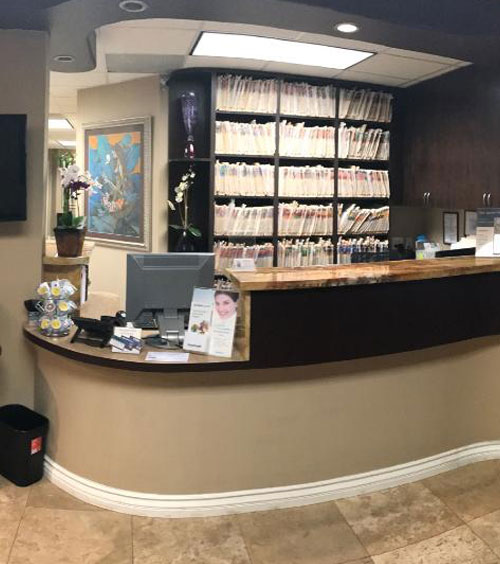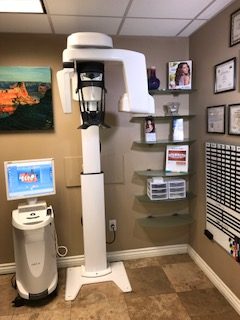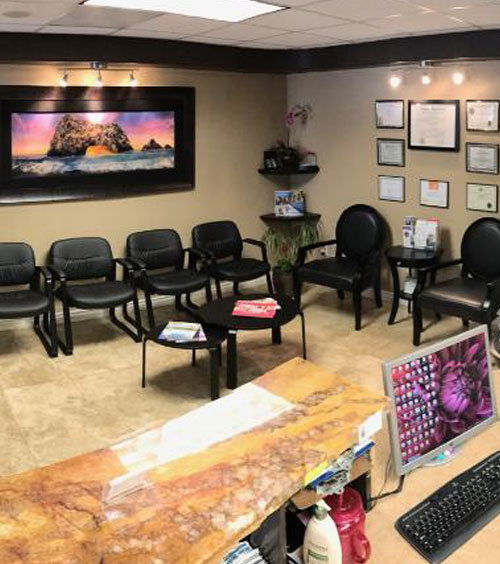Consider Laser Dentistry
Traditionally, gum disease treatment could have involved surgically opening the gum around the teeth to physically gain access to the root surfaces to remove plaque and tarter. In addition, non-supporting gum and bone would be removed, which leaves longer teeth. Therefore, this treatment may not be aesthetically pleasant, and tooth sensitivity to hot and cold may develop since the root surfaces would be exposed.
Laser periodontal treatment is an alternate to cutting and exposing root surfaces. LANAP is the name of the laser used at San Diego Dental Implants & Periodontics. LANAP is the FDA-approved laser for treatment of periodontal disease. LANAP will remove inflamed tissue without incision. The strength setting of LANAP is such that it would kill the bacteria within the tissue without damaging the tissue.
Comfort & Precision with Minimally Invasive Laser Treatments
How LANAP Works ?
Through research and development, scientists have discovered the wavelength at which only dark pigmented objects will be destroyed using LANAP. The bacteria that cause gum disease are dark pigmented, thus this particular laser can detect the bacteria and kill it, and not have any effect on the tissue. The protocol for using LANAP is to do thorough scaling and root planing with a Piezotome scaler (highly efficient motorized scaler), which is available at San Diego Dental Implants & Periodontics. The healthy gum can then be attached to the root surfaces, and minimal root exposure will occur afterward. In most every case, patients will not have much post-operative discomfort, and they will be able to go back to their normal activities
LANAP versus Traditional Gum Surgery
Being informed that you have gum disease which will require you to have gum surgery, can be scary if you don’t know anything about laser gum surgery or traditional gum surgery. In traditional surgery, the doctor uses a scalpel to push back the gum tissue. The pocket is then cleaned and the depth is reduced by cutting away the tissue. Many times, additional bone grafting or membrane materials are needed so as to reattach the gum tissues to the root surface of the teeth. There are times however, when the only treatment for patients is traditional surgery, but patients often choose LANAP which is not as invasive as, and is more comfortable than, traditional surgery.
LANAP (Laser Gum Surgery) uses neither a blade nor sutures. Laser gum surgery is less invasive resulting in less painful procedure for patients. The laser functions at a wavelength which is able to identify the diseased tissue from the healthy one. LANAP allows the doctor to remove both the bacteria and diseased tissue without removing, cutting or damaging the healthy tissue.
Can't Call Us Now?
Complete the form below and a member of our team will contact you at a more convenient time!
Laser Surgery Benefits
Pain
Traditional surgery will require pain medication and a recovery time due to the after surgery pain. That is why many patients choose dental implants to avoid the pain associated with gum surgery. With LANAP there is less discomfort and the patient can get back to work immediately.
Recession
The use of a blade in traditional surgery causes a reduction in the gum line. Traditional surgery can cause the gum line to be lowered from 2-4mm to as much as 10-15mm. Since LANAP is less invasive, it does not result in receding gum line. This is a significant difference since recession can result in several aesthetic problems; the teeth becoming sensitive to hot and cold temperatures.
Healing Time
With LANAP, your gum will heal faster than traditional surgery. The bacteria in the gum pockets are destroyed by the laser treatment with the chance of inflammation less likely and resulting in tissues that are healthier.
Long term results
Both treatments can produce great results; however LANAP is more prone to bone regeneration and reattached of the tissue to the root surfaces. Research has proven that the laser’s ability to stimulate the bone around the root of the tooth can encourage regeneration and save the tooth that would have been extracted previously.
LANAP may not be the treatment for every patient, but many patients can benefit from this treatment.








